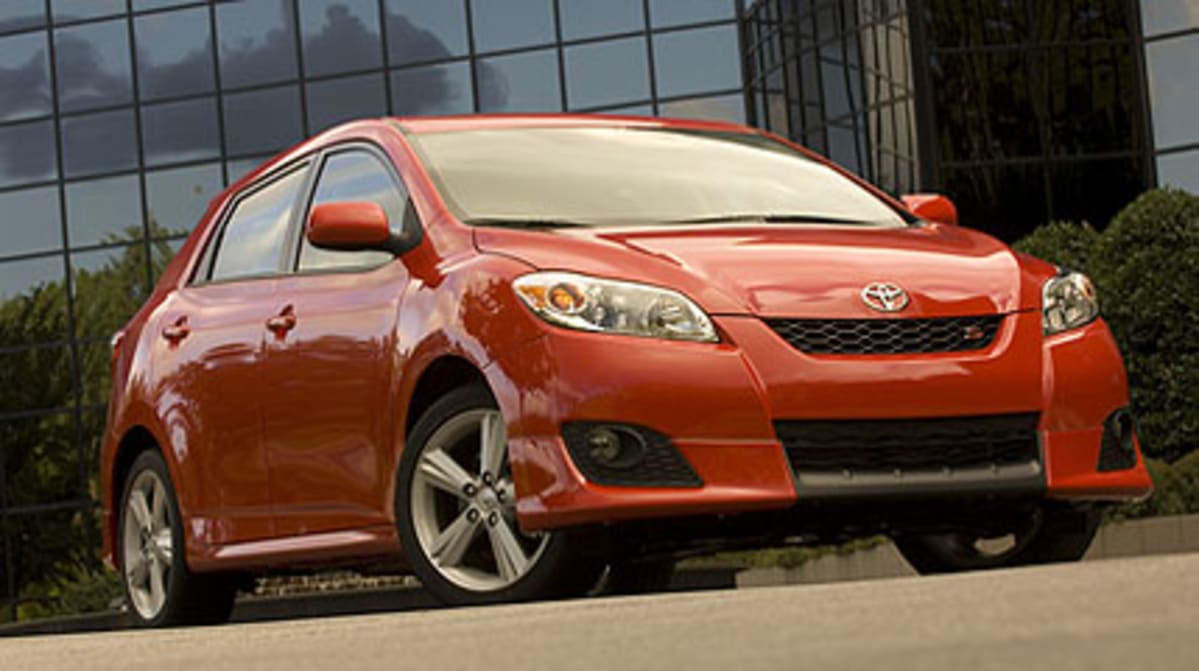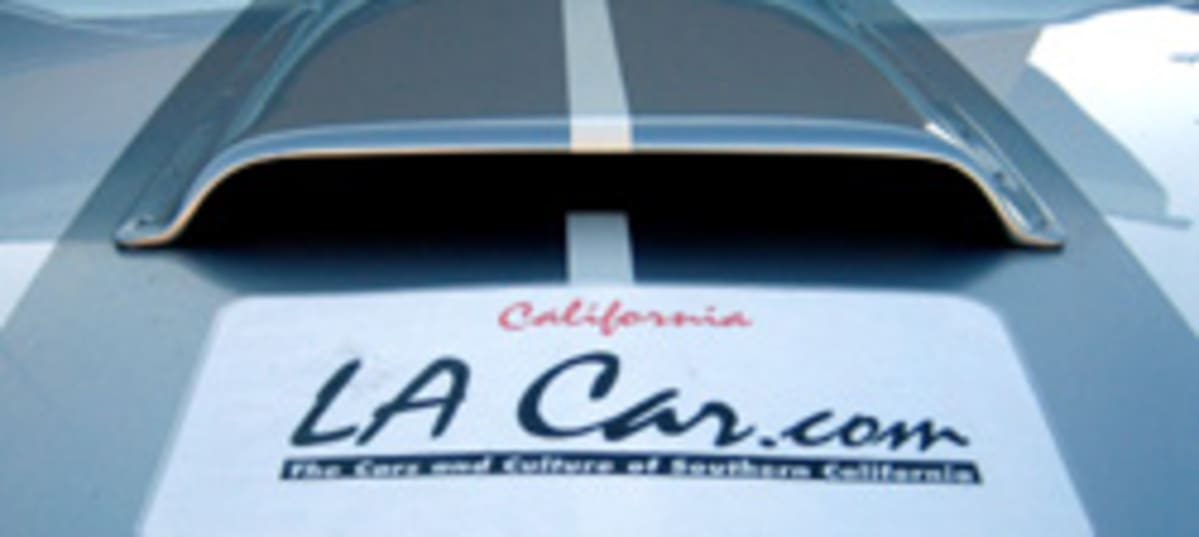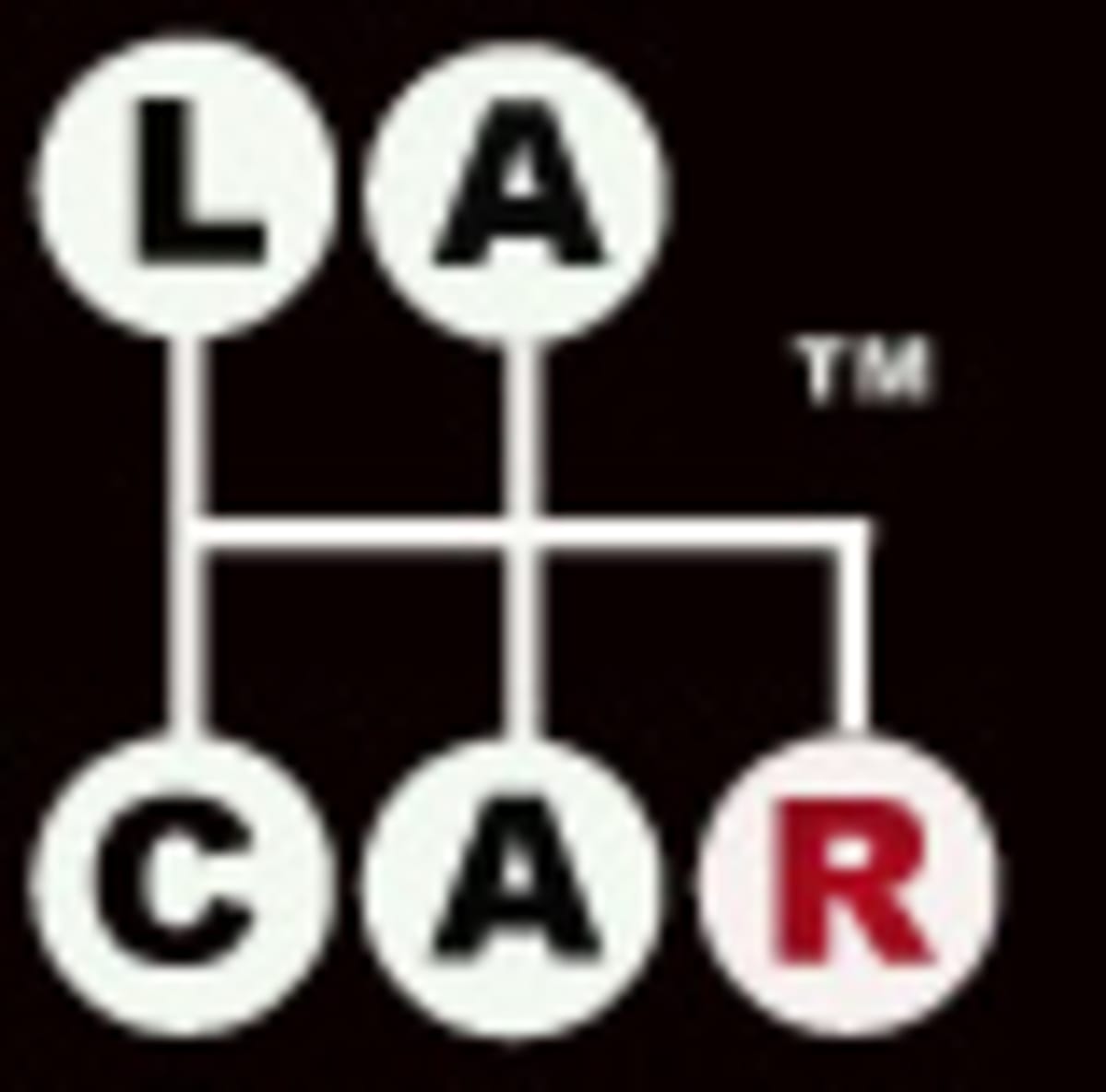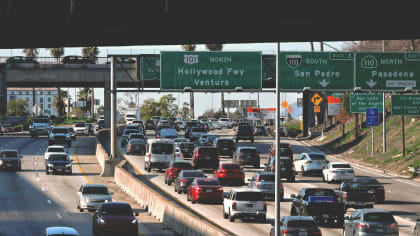BACK SEAT DRIVING - SEPTEMBER 2009
This article is from our archives and has not been updated and integrated with our "new" site yet... Even so, it's still awesome - so keep reading!
Published on Fri, Sep 4, 2009
By: The LACar Editorial Staff

Â
Mercedes Benz SLS AMG
BILL WRIGHT: BACK SEAT DRIVINGTHE
RETURN OF THE GULLWING
Mercedes reveals a new gullwing at Frankfurt
Not to be outdone by Audi, Mercedes had one of the absolute highlights of the
IAA in Frankfurt: The new Mercedes-Benz SLS AMG. The super sports car boasts a
unique design, extensive lightweight construction, outstanding handling and
exemplary safety. This is the result of a unique technology package consisting
of a lightweight aluminium space frame bodyshell with gullwing doors, the AMG
6.3 litre V8 front mid engine with dry sump lubrication, plus 420 kW/571 hp
output and 650 Newton metres of torque, the seven-speed dual clutch transmission
in transaxle format and sports suspension with aluminium double wishbone
geometry. The gullwing accelerates from 0 to 100 km/h in 3.8 seconds and goes on
to reach a top speed of 317 km/h. Its combined fuel consumption is 13.2 litres
per 100 kilometres (all values are preliminary).
Dr. Zetsche, "The new SLS AMG is a contemporary reinterpretation of the dream in
the form of a star. And this exceptional car is far from being a nostalgic
glimpse backwards. It is a determined step into the future. From the very start,
we conceived this amazing car with an electric-only driveline."
At IAA 2009, Mercedes-Benz is also presenting the technology for an
electric-drive SLS AMG with an emissions-free hi-tech driveline. Powerful
propulsion is provided courtesy of four electric motors with a combined output
of 392 kW and a maximum torque of 880 Newton metres. The "electric" gullwing
handles the sprint from 0 to 100 km/h in around four seconds, putting it on the
same high level as the SLS AMG with its 420 kW/571 hp AMG 6.3 litre V8 engine.
"Therefore" continues Dr. Zetsche, "the SLS is perhaps the most stunning proof
that driving fun has a future at Mercedes-Benz - with state-of-the-art internal
combustion engines and emissions-free electric drive."
Â
Â
Â
Â
Audi e-Tron concept
BILL WRIGHT: BACK SEAT DRIVINGAUDI
SINGS THE BODY ELECTRIC
Audi reveals the purely electric e-tron in Frankfurt
September 15, 2009 - Audi presents its highlight of the IAA 2009: the e-tron, a
high-performance sports car with a purely electric drive system. Four motors -
two each at the front and rear axles - drive the wheels, making the concept car
a true quattro. Producing 230 kW (313 hp) and 4,500 Nm (3,319.03 lb-ft) of
torque, the two-seater accelerates from 0 to 100 km/h (0 - 62.14 mph) in 4.8
seconds, and from 60 to 120 km/h (37.28 - 74.56 mph) in 4.1 seconds. The
lithium-ion battery provides a truly useable energy content of 42.4 kilowatt
hours to enable a range of approximately 248 kilometers, or 154 miles.
The package takes into account the specific realities of an electric vehicle.
The battery is directly behind the passenger cabin for an optimal center of
gravity and axle load distribution. Audi says the e-tron is able to freely
distribute the powerful torque of its four electric motors to the wheels as
required. This torque vectoring is said to allow for extraordinary dynamics and
an undreamed-of level of agility and precision when cornering.
Audi has taken a new approach to many of the technical modules. A heat pump is
used to efficiently warm up and heat the interior. The drive system, the power
electronics and the battery are controlled by an innovative thermal management
system that is a crucial component for achieving the car's range without
compromising its high level of interior comfort. Networking the vehicle
electronics with the surroundings, which is referred to as car-to-x
communication, opens new dimensions for the optimization of efficiency, safety
and convenience.
Drive System and Energy Supply
Four asynchronous motors with a total output of 230 kilowatts (313 hp) give the
Audi e-tron the performance of a high-output sports car. Audi says the concept
car can accelerate from 0 to 100 km/h (0 - 62.14 mph) in 4.8 seconds if
necessary, and goes from 60 to 120 km/h (37.28 - 74.56 mph) in 4.1 seconds. The
torque flows selectively to the wheels based on the driving situation and the
condition of the road surface, resulting in outstanding traction and handling.
The top speed is limited to 200 km/h (124.27 mph), as the amount of energy
required by the electric motors increases disproportionately to speed. The range
in the NECD combined cycle is approximately 248 kilometers (154 miles). This
good value is made possible by the integrated concept: technology specially
configured for the electric drive system combined with state-of-the-art battery
technology. The battery block has a total energy content of roughly 53 kilowatt
hours, with the usable portion thereof restricted to 42.4 kWh in the interest of
service life. Audi uses liquid cooling for the batteries.
The energy storage unit is charged with household current (230 volts, 16
amperes) via a cable and a plug. The socket is behind a cover at the back of the
car. With the battery fully discharged, the charging time is between 6 and 8
hours. A high voltage (400 volts, 63 amperes) reduces this to just around 2.5
hours. The Audi engineers are working on a wireless solution to make charging
more convenient. The inductive charging station, which can be placed in the
garage at home or also in special parking garages, is activated automatically
when the vehicle is docked. Such technology is already used today in a similar
form to charge electric toothbrushes.
The battery is charged when the car is stationary as well as when it is in
motion. This form of energy recovery and return to the battery is already
available today in a number of Audi production models. During braking, the
alternator converts the kinetic energy into electrical energy, which it then
feeds into the onboard electrical system.
The Audi e-tron, which is slowed by four lightweight ceramic brake discs, takes
the next large step into the future. An electronic brake system makes it
possible to tap into the recuperation potential of the electric motors. A
hydraulic fixed-caliper brake is mounted on the front axle, with two novel
electrically-actuated floating-caliper brakes mounted on the rear axle. These
floating calipers are actuated not by any mechanical or hydraulic transfer
elements, but rather by wire ("brake by wire"). In addition, this eliminates
frictional losses due to residual slip when the brakes are not being applied.
This decoupling of the brake pedal enables the e-tron's electric motors to
convert all of the braking energy into electricity and recover it. The
electromechanical brake system is only activated if greater deceleration is
required. These control actions are unnoticeable to the driver, who feels only a
predictable and constant pedal feel as with a hydraulic brake system.
Audi e-Tron
Driving Dynamics
The normal distribution of the tractive power is clearly biased toward the rear
axle in accordance with the weight distribution of the e-tron. Similarly to a
mid-engined sports car, roughly 70 percent of the power goes the rear and 30
percent to the front. If an axle slips, this balance can be varied by means of
the four centrally controlled electric motors. The electric vehicle from Audi
thus enjoys all of the advantages of quattro technology.
The four individual motors, which in the interest of greater traction are
installed behind the wheels as wheel drives, also enable the e-tron's lateral
dynamics to be intelligently controlled. Similar to what the sport differential
does in conventional quattro vehicles, torque vectoring - the targeted
acceleration of individual wheels - makes the e-tron even more dynamic while
simultaneously enhancing driving safety. Understeer and oversteer can be
corrected by not only targeted activation of the brakes, but also by precise
increases in power lasting just a few milliseconds. The concept car remains
extremely neutral even under great lateral acceleration and hustles through
corners as if on the proverbial rails.
The chassis has triangular double wishbones at the front axle and trapezoidal
wishbones made of forged aluminum components at the rear axle - a geometry that
has proven in motorsports to be the optimal prerequisite for high agility,
uncompromising precision and precisely defined self-steering behavior. A taut
setup was chosen for the springs and shock absorbers, but it is still very
comfortable.
The direct rack-and-pinion steering gives finely differentiated feedback. Its
electromechanical steering boost varies with speed, so that the e-tron only has
to provide energy while steering, and not while driving straight ahead.
As befitting its status, the Audi concept car rolls on 19-inch tires with a new
blade design. 235/35 tires up front and 295/30 tires in the rear provide the
necessary grip.
Car-to-x Communication
The buzzword "car-to-x communication" refers to the direct exchange of
information in flowing traffic and to the traffic environment. The letter "x" is
a free variable that can refer just as easily to other vehicles as to fixed
infrastructure such as traffic lights. In contrast to today's telematic systems,
car-to-x communication no longer requires a central service provider to quickly
and effectively pool and process information. The participants themselves
perform these tasks by spontaneously networking with one another.
The future car-to-x network still needs some time before it becomes reality on
the roads. This obstacle is one that can be overcome, however, as nearly every
carmaker in Europe, the U.S and Japan have decided to develop a common standard
for hardware and software. Once all new cars are equipped with this technology,
a functional network of automotive transmitters will soon be available, at least
in large population centers.
Â
Â
Â
Â
Audi Chair Rupert Statler and the R8 Spyder
BILL WRIGHT: BACK SEAT DRIVINGAUDI
R8 GOES TOPLESS IN FRANKFURT
On September 11, 2001, I was at the Internationale Automobil-Ausstellung,
otherwise known as the Frankfurt Motor Show. The show in Frankfurt occurs every
two years, and this marks my first return since that eventful moment eight years
ago.
While no Frankfurt Motor Show will ever etch my memory as the one in 2001, the
2009 IAA is certainly proving to be eventful. The event of the day: Audi
showcases a topless version of its supercar, the R8. The R8 Spyder 5.2 FSI
quattro comes only one way: With a V10 engine producing 386 kW (525 hp),
launching the open-top two-seater to 100 km/h (62.14 mph) in 4.1 seconds on its
way to a top speed of 313 km/h (194.49 mph). Its lightweight cloth top opens and
closes fully automatically; several body parts are made of a carbon fiber
composite material.
Of course, the R8 Spyder features the Audi Space Frame (ASF) and quattro
permanent all-wheel drive. Like every open-top Audi, the R8 Spyder 5.2 FSI
quattro has a cloth top. Audi argues that the soft top's approximate weight of a
mere 30 kilograms (66.14 lb) keeps the vehicle's total weight and center of
gravity low. Audi says the top also takes up little space when open, and tapers
off to two slim fins extending to the trailing edge of the car. Audi also claims
that the electrohydraulic soft top opens and closes in 19 seconds, even while
driving at speeds up to 50 km/h (31.07 mph).
In the version with manual transmission, the R8 Spyder 5.2 FSI quattro weighs
only 1,720 kilograms thanks primarily to its aluminum Audi Space Frame (ASF)
body. Despite reinforcements in the area of the sills, the center tunnel, the
rear wall, the floor pan and the A- and B-pillars, the body weighs only 216
kilograms (476.2 lb) - just 6 kilograms (13.23 lb) more than that of the R8
Coupé. The high stiffness of the ASF body, which includes an integrated engine
frame of ultra-lightweight magnesium, provides the foundation for the car's
dynamic handling and superior safety.
The Devil is in the Details
Numerous details demonstrate that the Audi designers put their hearts into the
design of the R8 Spyder 5.2 FSI quattro. The air inlets in the nose, which
direct air across the three radiators, and the lip of the front skirt are
painted high-gloss black. The struts in the broad, low, single-frame grille are
finely coated with chrome. The standard full-LED headlights are technical works
of art. Their reflectors resemble open mussel shells; the daytime running lights
appear to be a homogeneous strip, but actually comprise 24 individual LEDs that
form a curve at the lower edge of the headlight.
The full-LED headlights from Audi are unmatched by its international
competitors. Light-emitting diodes are used for the low beams, the high beams,
the daytime running lights and the turn signals. With a color temperature of
6,000 Kelvin, the LED light is very similar to daylight, making it easier on the
eyes when driving at night. Additional strengths include excellent light
distribution, long service life and extremely low energy consumption.
The side sills of the R8 Spyder 5.2 FSI quattro are broad and angular. V10
badges on the flanks allude to the power of the engine. A dark surface between
the rear lights emphasizes the car's width. The chambers of the lights are
colored dark red, with LEDs generating a three-dimensional light pattern. The
exhaust system ends in two large, oval tailpipes, and the fully lined underbody
ends in an upturned diffuser. The rear spoiler extends automatically at higher
speeds.
Audi offers the R8 Spyder 5.2 FSI quattro with a choice of three colors for the
top. The body is available in eleven paint finishes, with metallic and pearl
effect finishes standard. The windshield frame is coated with anodized aluminum.
The Heart of the R8 Spyder
The Audi R8 Spyder 5.2 FSI V10 engine is normally aspirated and produces 530 Nm
(390.91 lb-ft) of torque at 6,500 rpm. Peak output of 386 kW (525 hp) is reached
at 8,000 rpm, and the rev limit is not reached until 8,700 rpm. Specific power
output is 100.9 hp per liter of displacement; each hp only needs to move 3.3
kilograms (7.28 lb) of weight.
Performance reflects this awesome potential: 0-100 km/h (62.14 mph) in 4.1
seconds; 0-200 km/h (124.27 mph) in 12.7 seconds; top speed is 313 km/h (194.49
mph) with the six-speed manual transmission.
The 5.2-liter engine features FSI direct fuel injection. The high 12.5:1
compression ratio that this enables contributes to the high performance and good
fuel efficiency. Equipped with a manual transmission, the R8 Spyder 5.2 FSI
quattro consumes an average of 14.9 liters of fuel per 100 km (15.79 US mpg) - a
good figure given its power. With R tronic, this figure improves to 13.9 liters
(16.92 US mpg). Dry sump lubrication, another motorsports technology, ensures
that the supply of oil is maintained even at the maximum lateral acceleration of
1.2 g.
The Audi R8 Spyder 5.2 FSI is also available with an optional automatic
six-speed transmission. The R tronic offers a normal and a sport program as well
as a fully automatic and a manual mode. The manual mode allows the driver to
make lightning-fast gear changes using the joystick on the center tunnel or with
the paddles on the steering wheel. The open-air sports car also comes with
"Launch Control" - a program that manages engagement of the clutch perfectly to
maximize acceleration at start.
The Bottom Line
The Audi R8 Spyder 5.2 FSI quattro is built by quattro GmbH at the Neckarsulm
plant. The vehicle, including the ASF, is largely hand-built. The open-top
two-seater will be launched in Germany in the first quarter of 2010. Its base
price will be 156,400 euros.
US launch information for the R8 Spyder is not yet available.
Â
Â
Â
Corolla Matrix
NAKANO: BACK SEAT DRIVINGTHE
CASH FOR CLUNKERS TOP 10
Transportation Dept Releases Stats
The U.S. Department of Transportation has released its statistics on the Car
Allowance Rebate System (CARS), otherwise known as the Cash for Clunkers
program. With dealers submitting 690, 114 entries totaling an estimated value of
$2,877,900, here is what it looks like:
Top 10 New Vehicles Purchased
1. Toyota Corolla
2. Honda Civic
3. Toyota Camry
4. Ford Focus FWD
5. Hyundai Elantra
6. Nissan Versa
7. Toyota Prius
8. Honda Accord
9. Honda Fit
10. Ford Escape FWD
New Vehicles Manufacturers
Toyota 19.4%
General Motors 17.6%
Ford 14.4%
Honda 13.0%
Nissan 8.7%
Hyundai 7.2%
Chrysler 6.6%
Kia 4.3%
Subaru 2.5%
Mazda 2.4%
Volkswagen 2.0%
Suzuki 0.6%
Mitsubishi 0.5%
MINI 0.4%
Smart 0.2%
Volvo 0.1%
All Other <0.1%
Top 10 Trade-in Vehicles
1. Ford Explorer 4WD
2. Ford F150 Pickup 2WD
3. Jeep Grand Cherokee 4WD
4. Ford Explorer 2WD
5. Dodge Caravan/Grand Caravan 2WD
6. Jeep Cherokee 4WD
7. Chevrolet Blazer 4WD
8. Chevrolet C1500 Pickup 2WD
9. Ford F150 Pickup 4WD
10. Ford Windstar FWD Van
Vehicles Purchased by Category
Passenger Cars: 404,046
Category 1 Truck: 231,651
Category 2 Truck: 46,836
Category 3 Truck: 2,408
Vehicle Trade-in by Category
Passenger Cars: 109,380
Category 1 Truck: 450,778
Category 2 Truck: 116,909
Category 3 Truck: 8,134
84 percent of trade-ins under the program are trucks, and 59 percent of new
vehicles purchased are cars. "The program worked far better than anyone
anticipated at moving consumers out of old, dirty trucks and SUVs and into new
more fuel-efficient cars," said U.S. Transportation Secretary Ray LaHood.
Average Fuel Economy
New vehicles Mileage: 24.9 MPG
Trade-in Mileage: 15.8 MPG
Overall increase: 9.2 MPG, or a 58% improvement
Cars purchased under the program are, on average, 19 percent above the average
fuel economy of all new cars currently available, and 59 percent above the
average fuel economy of cars that were traded in. "This means the program raised
the average fuel economy of the fleet, while getting the dirtiest and most
polluting vehicles off the road," said LaHood.
To see LA Car's Cash for Clunkers Winners and Losers, click
here
Â
Â
Â
A
JOURNAL OF LOS ANGELES & ITS CAR CULTURE That
was LA Car's subtitle when it started back in 1997. It's original website
address was about five times the size of lacar.com. Since then, La Car
became LA Car. Its subtitle became
Reporting From Car Culture Ground Zero, then From The Heart of Car
Culture, to today's The Cars and Culture of Southern California. At
all times, however, we aimed to chronicle the Southland's automotive spirit - much like
one's own
journal or diary.
LA Car has always been a great source
to come back to from week-to-week, to see what articles and reviews have been
added to our rather staggering database. With Back Seat Driving, a.k.a.
BSD (note the similarity to two well-worn abbreviations, BS and BFD) and Hot
Wires - Hot & Tender News From the Car Culture (co-located with Back Seat
Driving, and updated at least daily), we give you some reasons to
come back more often (all opinions, by the way, are those of the respective
author).
So, go
ahead and bookmark www.lacar.com. We'll be
sure to always provide a link to Hot Wires and the latest Back Seat
Driving blog entry. In the meantime, welcome to the journal and journey from
the heart of the car culture. - Roy NakanoÂ
For
past Back Seat Driving and LA Car Blog entries, click the
Archives.
 










